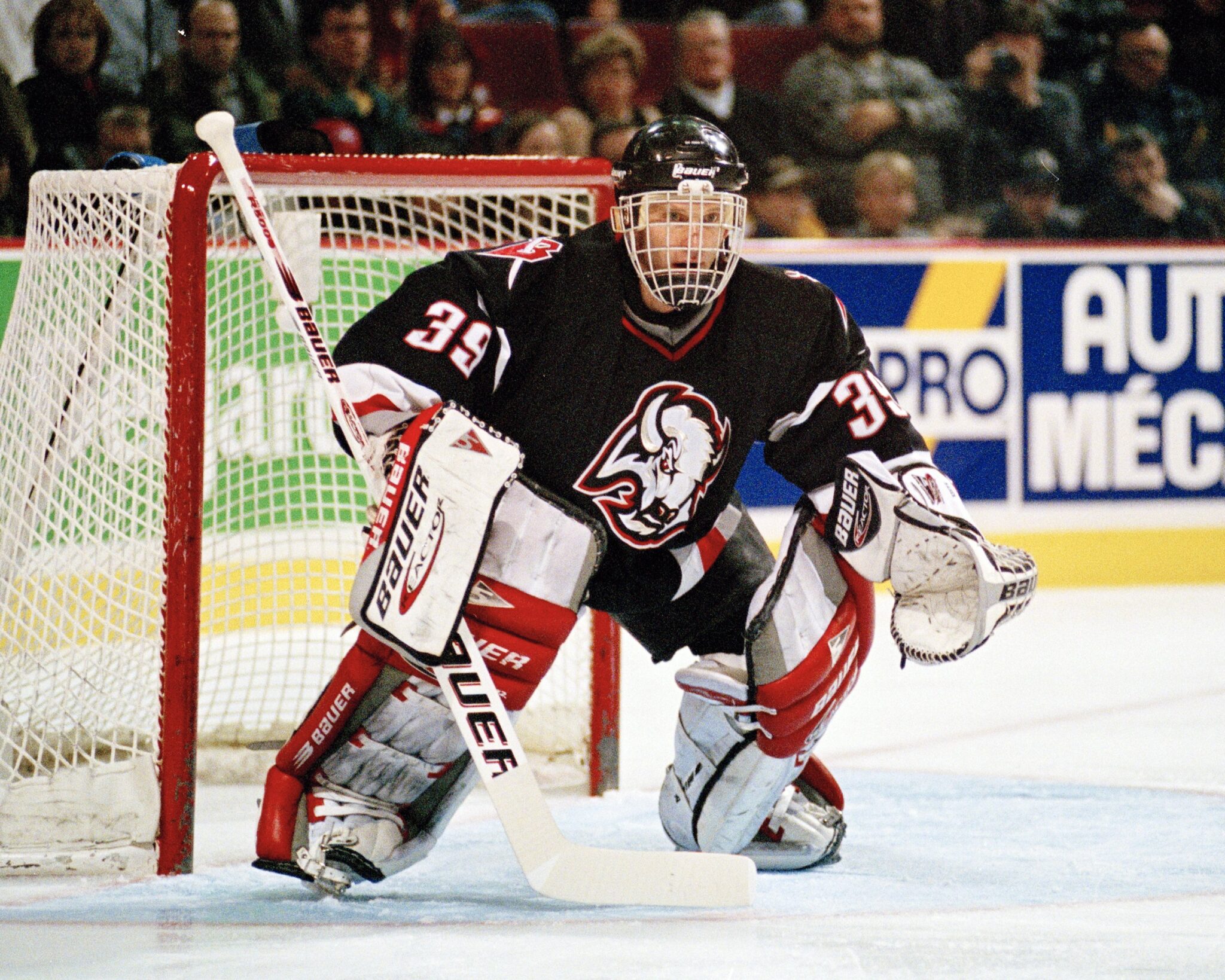Stepping into a true starter role for the first time in the league at age 28, Dominik Hasek entered the limelight in 1993, a time in which Patrick Roy was cementing himself as an NHL great and Martin Brodeur was already the next up-and-coming star goalie. Hasek wasn’t supposed to be in the starter’s net — a Grant Fuhr injury forced him into the position — but the Sabres’ goaltender forced his way into a permanent slot being the workhorse.
Hasek’s Sabres Tenure
In 1994-95, his first full season as the bonafide No. 1 for Buffalo, Hasek started 41 of 48 games in a lockout-shortened season. Nonetheless, he led the league in save percentage (SV%) of .930 and goals-against average (GAA) of 2.11, bringing home the Vezina Trophy and receiving runner-up honors for the Hart. He single-handedly dragged the injury-plagued Sabres squad to a playoff berth, where they ultimately lost in the first round to the eventual Stanley Cup finalist New Jersey Devils. Hasek made sure they adequately exhausted the Devils, though, posting a 70-save shutout in game 6, extending the Sabres’ hopes of advancing to the next round.
In five subsequent years, Hasek would win four more Vezina Trophies, becoming the first and only goaltender to win back-to-back Hart Trophies from 1996-1998. In a time when Martin Brodeur and Patrick Roy were still in their primes, Hasek stood as the undisputed best goaltender in the league during this stretch. His SV% during this time was an astounding .927, and his GAA was an equally astonishing 2.25.
Year in and year out, Hasek, having firmly earned the nickname “The Dominator,” carried the Sabres to undeserved playoff appearances. Teams headlined by Derek Plante, who scored a career-high of just 27 goals during the 1996-97 season in a year where there were four 50-plus goal scorers, were able to be berthed into the postseason solely on the shoulders of Hasek.
His regular season success hit its ceiling in a three-year span from 1996-1999. In 1996-97, Hasek set a league record with a .930 SV%, only to break it himself in both of the subsequent years. He became the only goaltender in NHL history to lead the league in shots faced per 60 minutes as well as SV% (and he did it two times!). His highest GAA in this span was an astounding 2.27. Oh, and he did it while starting 203 of a possible 246 games.

The last year in that unfathomable stretch of hockey that culminated in a miracle playoff run in the 1998-99 season. Buffalo had once again snuck into the playoffs with an uninteresting lineup — their leading scorer, Miroslav Satan, had 66 points — as the No. 7 seed in the Eastern Conference. In the playoffs, it was more of the same: Hasek putting the Sabres on his back as the team in front of him struggled to score many goals. Hasek didn’t just put the Sabres on his back, though. He dominated. In 19 games, he supplied Buffalo with a .939 SV% and a 1.77 GAA. Ultimately, the Sabres lost in the Final in heartbreaking fashion, with Brett Hull knocking home the game-winner with his foot in the crease (which, at the time, was a violation).
In his nine years with the Sabres, The Dominator amassed six Vezina Trophies, two Hart Trophies (among many nominations), two Ted Lindsay awards, and forced an undeserving Buffalo team to the playoffs in every year he was the starter. Not to mention his counting stats; Hasek boasted a .926 SV% and a 2.22 GAA over 491 games — a masterful stretch that was never, and will never be, replicated.
Post Sabres
When the 2001-02 season came around, Hasek was outwardly frustrated with his lack of playoff success. After all, he solidified himself as the league’s best goaltender and collected countless individual trophies. For all intents and purposes, though, he didn’t care about that. He wanted to win a Cup.
So, Hasek threatened the Sabres organization with retirement unless he was traded to a contender. And thus, he was dealt to the Detroit Red Wings, a team filled to the brim with future Hall-of-Fame talents — nine of them, to be precise. To nobody’s surprise, Hasek and the Red Wings cruised to a Presidents’ Trophy and an eventual Stanley Cup victory in just his first year with the team. It wasn’t just the star-studded cast bringing the team that far; Hasek still posted a more-than-respectable .915 SV% and a GAA of just 2.17 in the regular season and a respective .920 and 1.87 in the playoffs.

Hasek continued his dominance throughout the rest of his career, supplying Ottawa with Vezina finalist-caliber goaltending for a season in 2005-06 before returning to the Red Wings, where he ultimately won another Stanley Cup in 2007-08. All in all, post-Buffalo, Hasek sported a .912 SV% and a GAA of just 2.13. He retired at age 43, just after winning his second Cup. All in all, despite coming into a starter role at the age of 28, The Dominator won 389 games (81 in shutout fashion), accruing a career .922 SV% and 2.20 GAA. He won six Vezinas, two Harts, two Ted Lindsays, and two Stanley Cups, as well as being named to the NHL First-All-Star team six times.
Hasek’s International Success
While his 16-year NHL career is already enough to cement Hasek as among the — if not the — greatest goaltenders of all time, his success on the international stage adds another facet to his illustrious career. In fact, Hasek himself considers the 1998 Olympic Games his greatest achievement. Facing stacked Canadian, Russian, and American rosters headlined by countless Hall-of-Fame talents, Hasek singlehandedly ensured that the Czech Republic would bring home a gold medal, stymying the three juggernauts en route to an Olympic victory. He ended up posting a 0.97 GAA and .961 SV% during the tournament.
Latest News & Highlights
Hasek’s international success shouldn’t just be quantified by tournament victories, though. When he entered the NHL, while there were many European players, the net was dominated by North Americans. In fact, Hasek was the first European goaltender to enter the league. Since his entrance to the NHL, the number of non-North American goaltenders has increased every year, with the likes of Igor Shesterkin and Ilya Sorokin among the best active goalies. Without Hasek’s migration into the league, it’s entirely possible that the net would still be crowded with North American players.
Hasek and his unconventional, flailing goaltender style paved the way for European goaltending in the NHL. That alone should cement him as one of the league’s greatest influences. Pair that with his utter dominance in the NHL for 16 years, his individual accolades, and his success in the playoffs, and it’s indisputable that he is the greatest goaltender in the history of the league.

